An Analysis of Partnership Working in Health and Social Care: A Report
VerifiedAdded on 2023/01/11
|11
|3183
|88
Report
AI Summary
This report provides an in-depth analysis of partnership working within the health and social care sectors. It begins by defining the philosophies and concepts underpinning effective partnerships, emphasizing the importance of empowerment, respect, and collaboration. The report then explores various partnership models, such as unified, coordinated, and hybrid approaches, and their implications for service delivery. Legislation and organizational practices, including the Health and Social Care Act 2012, Mental Health Capacity Act 2005, and Data Protection Act 1998, are examined to understand their influence on partnership working. The report also addresses differences in working practices across health and social care, highlighting the need for effective communication and information sharing among professionals. Section C focuses on the outcomes of partnership working for service users, professionals, and organizations, including the identification of potential barriers and strategies to improve outcomes. The case of Mr. Ian is used throughout the report to illustrate these concepts, emphasizing the impact of partnership working on service delivery and patient outcomes. The report concludes by summarizing the key findings and recommendations for fostering successful partnerships in health and social care.

Working in
Partnership
Partnership
Paraphrase This Document
Need a fresh take? Get an instant paraphrase of this document with our AI Paraphraser
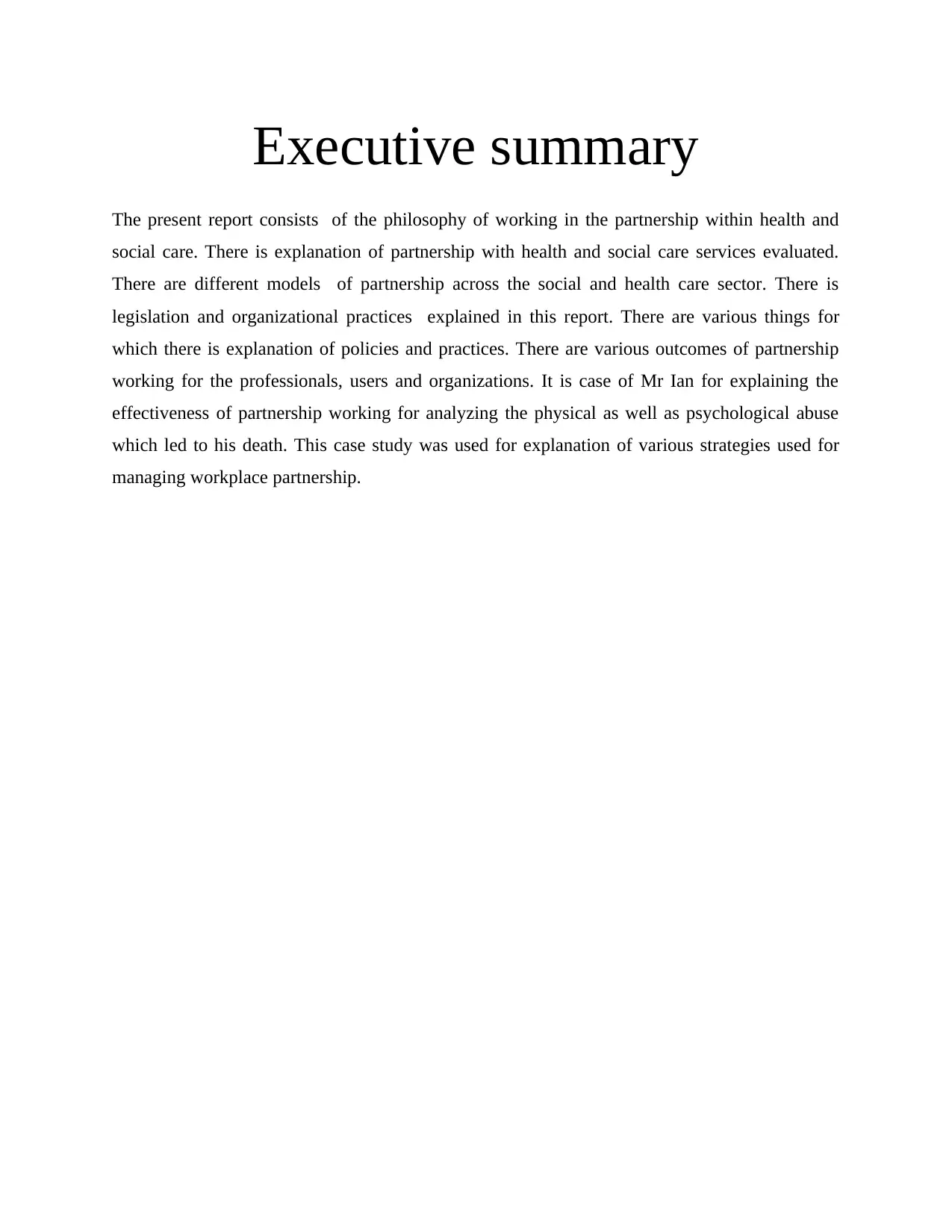
Executive summary
The present report consists of the philosophy of working in the partnership within health and
social care. There is explanation of partnership with health and social care services evaluated.
There are different models of partnership across the social and health care sector. There is
legislation and organizational practices explained in this report. There are various things for
which there is explanation of policies and practices. There are various outcomes of partnership
working for the professionals, users and organizations. It is case of Mr Ian for explaining the
effectiveness of partnership working for analyzing the physical as well as psychological abuse
which led to his death. This case study was used for explanation of various strategies used for
managing workplace partnership.
The present report consists of the philosophy of working in the partnership within health and
social care. There is explanation of partnership with health and social care services evaluated.
There are different models of partnership across the social and health care sector. There is
legislation and organizational practices explained in this report. There are various things for
which there is explanation of policies and practices. There are various outcomes of partnership
working for the professionals, users and organizations. It is case of Mr Ian for explaining the
effectiveness of partnership working for analyzing the physical as well as psychological abuse
which led to his death. This case study was used for explanation of various strategies used for
managing workplace partnership.

Table of Contents
INTRODUCTION...........................................................................................................................4
SECTION A.....................................................................................................................................4
Philosophies and concepts of working in partnership in health and social care..........................4
Partnership relationships within health and social care...............................................................4
SECTION B.....................................................................................................................................4
Models of partnership working across the health and social care sector.....................................4
Legislation and organisational practices and policies for partnership in health and social care. 5
Differences in working practices across the health and social care sector..................................6
SECTION C.....................................................................................................................................6
Outcomes of partnership working for users of services, professional and organisations............6
Barriers to partnership working in health and social care...........................................................7
Strategies to improve outcomes for partnership working in health and social care services......8
Conclusion.......................................................................................................................................8
REFERENCES..............................................................................................................................10
INTRODUCTION...........................................................................................................................4
SECTION A.....................................................................................................................................4
Philosophies and concepts of working in partnership in health and social care..........................4
Partnership relationships within health and social care...............................................................4
SECTION B.....................................................................................................................................4
Models of partnership working across the health and social care sector.....................................4
Legislation and organisational practices and policies for partnership in health and social care. 5
Differences in working practices across the health and social care sector..................................6
SECTION C.....................................................................................................................................6
Outcomes of partnership working for users of services, professional and organisations............6
Barriers to partnership working in health and social care...........................................................7
Strategies to improve outcomes for partnership working in health and social care services......8
Conclusion.......................................................................................................................................8
REFERENCES..............................................................................................................................10
⊘ This is a preview!⊘
Do you want full access?
Subscribe today to unlock all pages.

Trusted by 1+ million students worldwide

INTRODUCTION
The working of partnership is known as the evaluation of people’s behaviour while working
together professionally. It is used for attaining the organisational goals and targets by working
together. The working of partnership is very important for the social and health care sector. It
helps in efficiency and effectiveness of the professionals working on the health area. It is useful
for managing the working of the people who are involved in the health and social care. There is
explanation of philosophy of working in partnership, models of partnership, relationships of
partnership in the health and social care sector. There is also explanation of legislation and
policies of the organisation. There is also explanation of potential barriers for the partnership
working and the strategies for partnership for improving the functioning of an organisation.
These all concepts are explained using Ian’s case study.
SECTION A
Philosophies and concepts of working in partnership in health and social care
The philosophy of working in partnership is defined as the way in which different professionals
come together from different backgrounds in order to achieve similar targets and goals. This
consists of working together with various service users like independence, empowerment, power
sharing and autonomy for meeting the needs and demands of individuals.
Empowerment is defined as the phase power and encouraged when individuals are provided
power and they are encouraged for carrying out a good plan which will help in achieving the
goals effectively. This is a good process to take control over power and claiming the rights of an
individual. If there is no empowerment, then there are individuals who have to rely on carers. In
context of Mr. Ian case study, he was or empowered by the professionals for providing care to
him. There are professionals who were looking for the assessing of risk plan. Mr. Ian was having
problem of alcoholism and he was not able to find a good solution for overcoming this problem.
Respect on the other hand is known as treatment of individuals with politeness and courtesy.
This encourages workers for expressing their ideas and views in proper manner. Mr. Ian was
given respect but not empowered. The professionals are not working as team and they did not
know what are their responsibilities and roles. There was no effective communication and and
monitoring of the care plan.
The working of partnership is known as the evaluation of people’s behaviour while working
together professionally. It is used for attaining the organisational goals and targets by working
together. The working of partnership is very important for the social and health care sector. It
helps in efficiency and effectiveness of the professionals working on the health area. It is useful
for managing the working of the people who are involved in the health and social care. There is
explanation of philosophy of working in partnership, models of partnership, relationships of
partnership in the health and social care sector. There is also explanation of legislation and
policies of the organisation. There is also explanation of potential barriers for the partnership
working and the strategies for partnership for improving the functioning of an organisation.
These all concepts are explained using Ian’s case study.
SECTION A
Philosophies and concepts of working in partnership in health and social care
The philosophy of working in partnership is defined as the way in which different professionals
come together from different backgrounds in order to achieve similar targets and goals. This
consists of working together with various service users like independence, empowerment, power
sharing and autonomy for meeting the needs and demands of individuals.
Empowerment is defined as the phase power and encouraged when individuals are provided
power and they are encouraged for carrying out a good plan which will help in achieving the
goals effectively. This is a good process to take control over power and claiming the rights of an
individual. If there is no empowerment, then there are individuals who have to rely on carers. In
context of Mr. Ian case study, he was or empowered by the professionals for providing care to
him. There are professionals who were looking for the assessing of risk plan. Mr. Ian was having
problem of alcoholism and he was not able to find a good solution for overcoming this problem.
Respect on the other hand is known as treatment of individuals with politeness and courtesy.
This encourages workers for expressing their ideas and views in proper manner. Mr. Ian was
given respect but not empowered. The professionals are not working as team and they did not
know what are their responsibilities and roles. There was no effective communication and and
monitoring of the care plan.
Paraphrase This Document
Need a fresh take? Get an instant paraphrase of this document with our AI Paraphraser
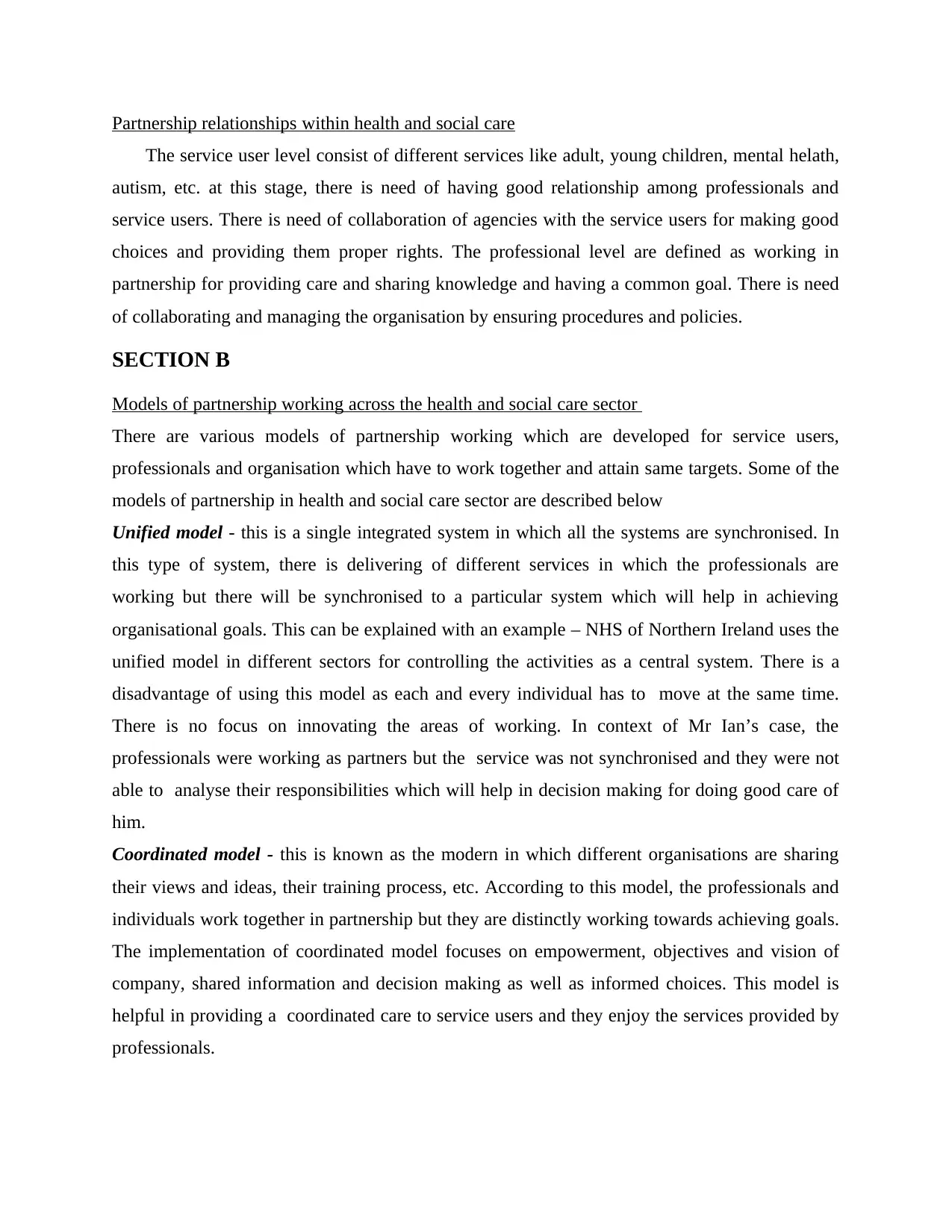
Partnership relationships within health and social care
The service user level consist of different services like adult, young children, mental helath,
autism, etc. at this stage, there is need of having good relationship among professionals and
service users. There is need of collaboration of agencies with the service users for making good
choices and providing them proper rights. The professional level are defined as working in
partnership for providing care and sharing knowledge and having a common goal. There is need
of collaborating and managing the organisation by ensuring procedures and policies.
SECTION B
Models of partnership working across the health and social care sector
There are various models of partnership working which are developed for service users,
professionals and organisation which have to work together and attain same targets. Some of the
models of partnership in health and social care sector are described below
Unified model - this is a single integrated system in which all the systems are synchronised. In
this type of system, there is delivering of different services in which the professionals are
working but there will be synchronised to a particular system which will help in achieving
organisational goals. This can be explained with an example – NHS of Northern Ireland uses the
unified model in different sectors for controlling the activities as a central system. There is a
disadvantage of using this model as each and every individual has to move at the same time.
There is no focus on innovating the areas of working. In context of Mr Ian’s case, the
professionals were working as partners but the service was not synchronised and they were not
able to analyse their responsibilities which will help in decision making for doing good care of
him.
Coordinated model - this is known as the modern in which different organisations are sharing
their views and ideas, their training process, etc. According to this model, the professionals and
individuals work together in partnership but they are distinctly working towards achieving goals.
The implementation of coordinated model focuses on empowerment, objectives and vision of
company, shared information and decision making as well as informed choices. This model is
helpful in providing a coordinated care to service users and they enjoy the services provided by
professionals.
The service user level consist of different services like adult, young children, mental helath,
autism, etc. at this stage, there is need of having good relationship among professionals and
service users. There is need of collaboration of agencies with the service users for making good
choices and providing them proper rights. The professional level are defined as working in
partnership for providing care and sharing knowledge and having a common goal. There is need
of collaborating and managing the organisation by ensuring procedures and policies.
SECTION B
Models of partnership working across the health and social care sector
There are various models of partnership working which are developed for service users,
professionals and organisation which have to work together and attain same targets. Some of the
models of partnership in health and social care sector are described below
Unified model - this is a single integrated system in which all the systems are synchronised. In
this type of system, there is delivering of different services in which the professionals are
working but there will be synchronised to a particular system which will help in achieving
organisational goals. This can be explained with an example – NHS of Northern Ireland uses the
unified model in different sectors for controlling the activities as a central system. There is a
disadvantage of using this model as each and every individual has to move at the same time.
There is no focus on innovating the areas of working. In context of Mr Ian’s case, the
professionals were working as partners but the service was not synchronised and they were not
able to analyse their responsibilities which will help in decision making for doing good care of
him.
Coordinated model - this is known as the modern in which different organisations are sharing
their views and ideas, their training process, etc. According to this model, the professionals and
individuals work together in partnership but they are distinctly working towards achieving goals.
The implementation of coordinated model focuses on empowerment, objectives and vision of
company, shared information and decision making as well as informed choices. This model is
helpful in providing a coordinated care to service users and they enjoy the services provided by
professionals.
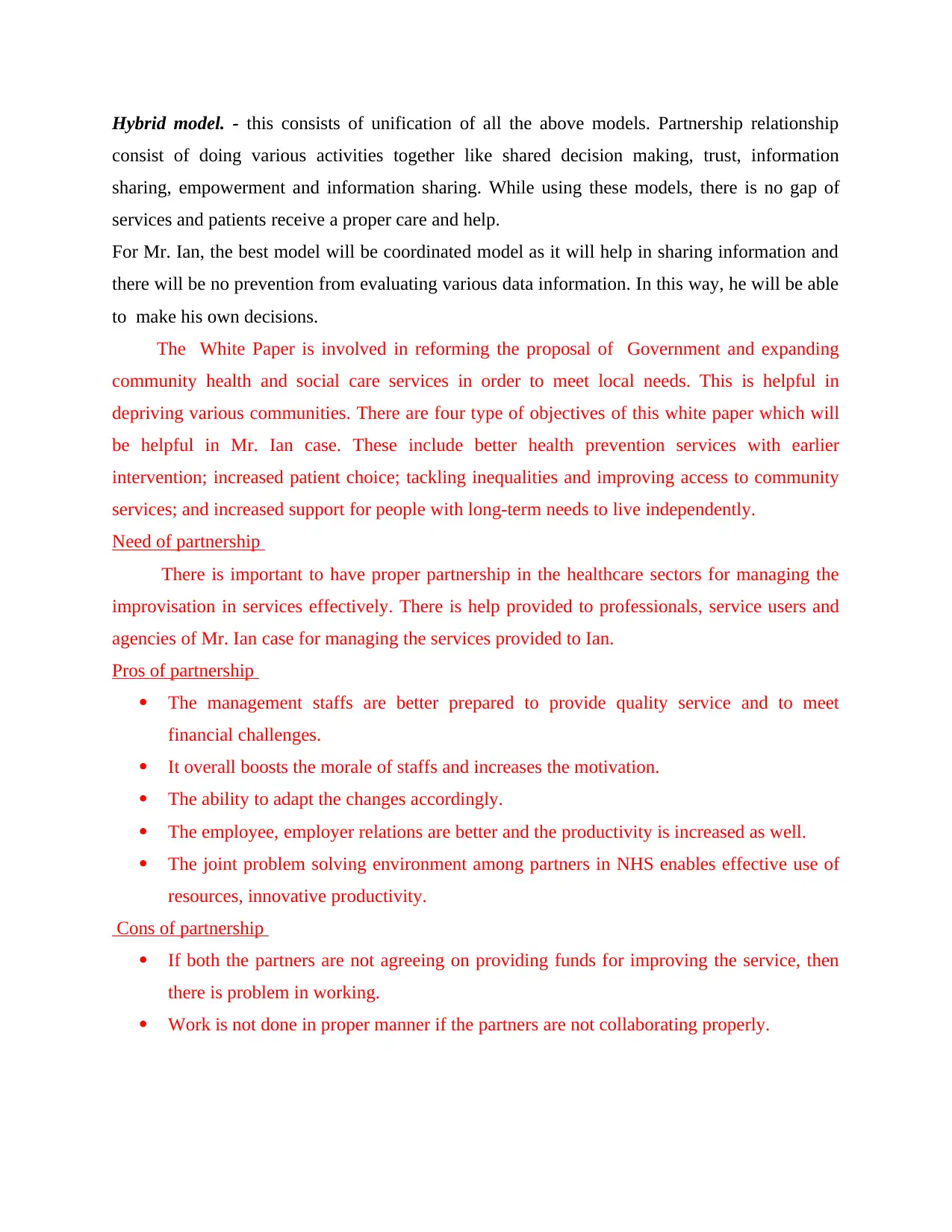
Hybrid model. - this consists of unification of all the above models. Partnership relationship
consist of doing various activities together like shared decision making, trust, information
sharing, empowerment and information sharing. While using these models, there is no gap of
services and patients receive a proper care and help.
For Mr. Ian, the best model will be coordinated model as it will help in sharing information and
there will be no prevention from evaluating various data information. In this way, he will be able
to make his own decisions.
The White Paper is involved in reforming the proposal of Government and expanding
community health and social care services in order to meet local needs. This is helpful in
depriving various communities. There are four type of objectives of this white paper which will
be helpful in Mr. Ian case. These include better health prevention services with earlier
intervention; increased patient choice; tackling inequalities and improving access to community
services; and increased support for people with long-term needs to live independently.
Need of partnership
There is important to have proper partnership in the healthcare sectors for managing the
improvisation in services effectively. There is help provided to professionals, service users and
agencies of Mr. Ian case for managing the services provided to Ian.
Pros of partnership
The management staffs are better prepared to provide quality service and to meet
financial challenges.
It overall boosts the morale of staffs and increases the motivation.
The ability to adapt the changes accordingly.
The employee, employer relations are better and the productivity is increased as well.
The joint problem solving environment among partners in NHS enables effective use of
resources, innovative productivity.
Cons of partnership
If both the partners are not agreeing on providing funds for improving the service, then
there is problem in working.
Work is not done in proper manner if the partners are not collaborating properly.
consist of doing various activities together like shared decision making, trust, information
sharing, empowerment and information sharing. While using these models, there is no gap of
services and patients receive a proper care and help.
For Mr. Ian, the best model will be coordinated model as it will help in sharing information and
there will be no prevention from evaluating various data information. In this way, he will be able
to make his own decisions.
The White Paper is involved in reforming the proposal of Government and expanding
community health and social care services in order to meet local needs. This is helpful in
depriving various communities. There are four type of objectives of this white paper which will
be helpful in Mr. Ian case. These include better health prevention services with earlier
intervention; increased patient choice; tackling inequalities and improving access to community
services; and increased support for people with long-term needs to live independently.
Need of partnership
There is important to have proper partnership in the healthcare sectors for managing the
improvisation in services effectively. There is help provided to professionals, service users and
agencies of Mr. Ian case for managing the services provided to Ian.
Pros of partnership
The management staffs are better prepared to provide quality service and to meet
financial challenges.
It overall boosts the morale of staffs and increases the motivation.
The ability to adapt the changes accordingly.
The employee, employer relations are better and the productivity is increased as well.
The joint problem solving environment among partners in NHS enables effective use of
resources, innovative productivity.
Cons of partnership
If both the partners are not agreeing on providing funds for improving the service, then
there is problem in working.
Work is not done in proper manner if the partners are not collaborating properly.
⊘ This is a preview!⊘
Do you want full access?
Subscribe today to unlock all pages.

Trusted by 1+ million students worldwide
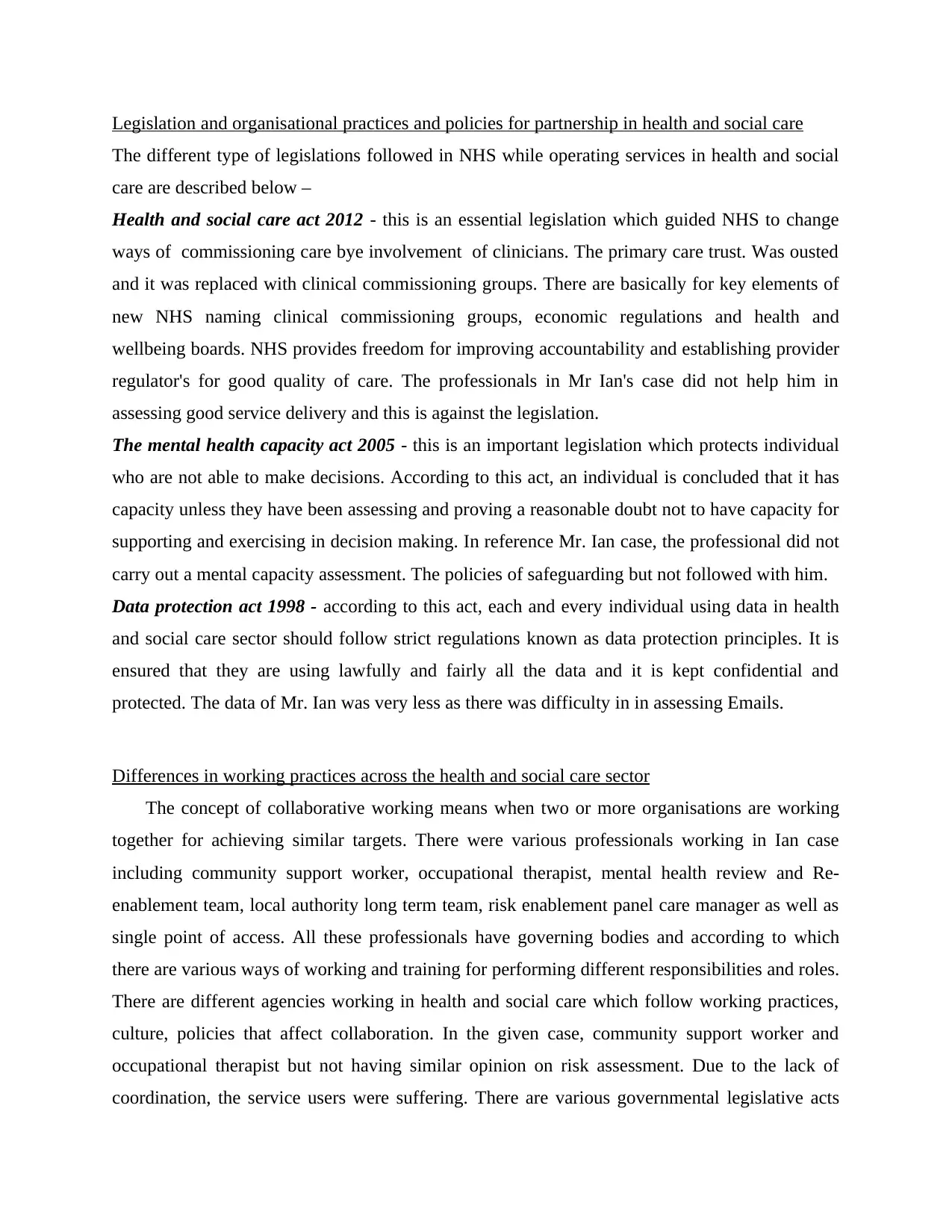
Legislation and organisational practices and policies for partnership in health and social care
The different type of legislations followed in NHS while operating services in health and social
care are described below –
Health and social care act 2012 - this is an essential legislation which guided NHS to change
ways of commissioning care bye involvement of clinicians. The primary care trust. Was ousted
and it was replaced with clinical commissioning groups. There are basically for key elements of
new NHS naming clinical commissioning groups, economic regulations and health and
wellbeing boards. NHS provides freedom for improving accountability and establishing provider
regulator's for good quality of care. The professionals in Mr Ian's case did not help him in
assessing good service delivery and this is against the legislation.
The mental health capacity act 2005 - this is an important legislation which protects individual
who are not able to make decisions. According to this act, an individual is concluded that it has
capacity unless they have been assessing and proving a reasonable doubt not to have capacity for
supporting and exercising in decision making. In reference Mr. Ian case, the professional did not
carry out a mental capacity assessment. The policies of safeguarding but not followed with him.
Data protection act 1998 - according to this act, each and every individual using data in health
and social care sector should follow strict regulations known as data protection principles. It is
ensured that they are using lawfully and fairly all the data and it is kept confidential and
protected. The data of Mr. Ian was very less as there was difficulty in in assessing Emails.
Differences in working practices across the health and social care sector
The concept of collaborative working means when two or more organisations are working
together for achieving similar targets. There were various professionals working in Ian case
including community support worker, occupational therapist, mental health review and Re-
enablement team, local authority long term team, risk enablement panel care manager as well as
single point of access. All these professionals have governing bodies and according to which
there are various ways of working and training for performing different responsibilities and roles.
There are different agencies working in health and social care which follow working practices,
culture, policies that affect collaboration. In the given case, community support worker and
occupational therapist but not having similar opinion on risk assessment. Due to the lack of
coordination, the service users were suffering. There are various governmental legislative acts
The different type of legislations followed in NHS while operating services in health and social
care are described below –
Health and social care act 2012 - this is an essential legislation which guided NHS to change
ways of commissioning care bye involvement of clinicians. The primary care trust. Was ousted
and it was replaced with clinical commissioning groups. There are basically for key elements of
new NHS naming clinical commissioning groups, economic regulations and health and
wellbeing boards. NHS provides freedom for improving accountability and establishing provider
regulator's for good quality of care. The professionals in Mr Ian's case did not help him in
assessing good service delivery and this is against the legislation.
The mental health capacity act 2005 - this is an important legislation which protects individual
who are not able to make decisions. According to this act, an individual is concluded that it has
capacity unless they have been assessing and proving a reasonable doubt not to have capacity for
supporting and exercising in decision making. In reference Mr. Ian case, the professional did not
carry out a mental capacity assessment. The policies of safeguarding but not followed with him.
Data protection act 1998 - according to this act, each and every individual using data in health
and social care sector should follow strict regulations known as data protection principles. It is
ensured that they are using lawfully and fairly all the data and it is kept confidential and
protected. The data of Mr. Ian was very less as there was difficulty in in assessing Emails.
Differences in working practices across the health and social care sector
The concept of collaborative working means when two or more organisations are working
together for achieving similar targets. There were various professionals working in Ian case
including community support worker, occupational therapist, mental health review and Re-
enablement team, local authority long term team, risk enablement panel care manager as well as
single point of access. All these professionals have governing bodies and according to which
there are various ways of working and training for performing different responsibilities and roles.
There are different agencies working in health and social care which follow working practices,
culture, policies that affect collaboration. In the given case, community support worker and
occupational therapist but not having similar opinion on risk assessment. Due to the lack of
coordination, the service users were suffering. There are various governmental legislative acts
Paraphrase This Document
Need a fresh take? Get an instant paraphrase of this document with our AI Paraphraser
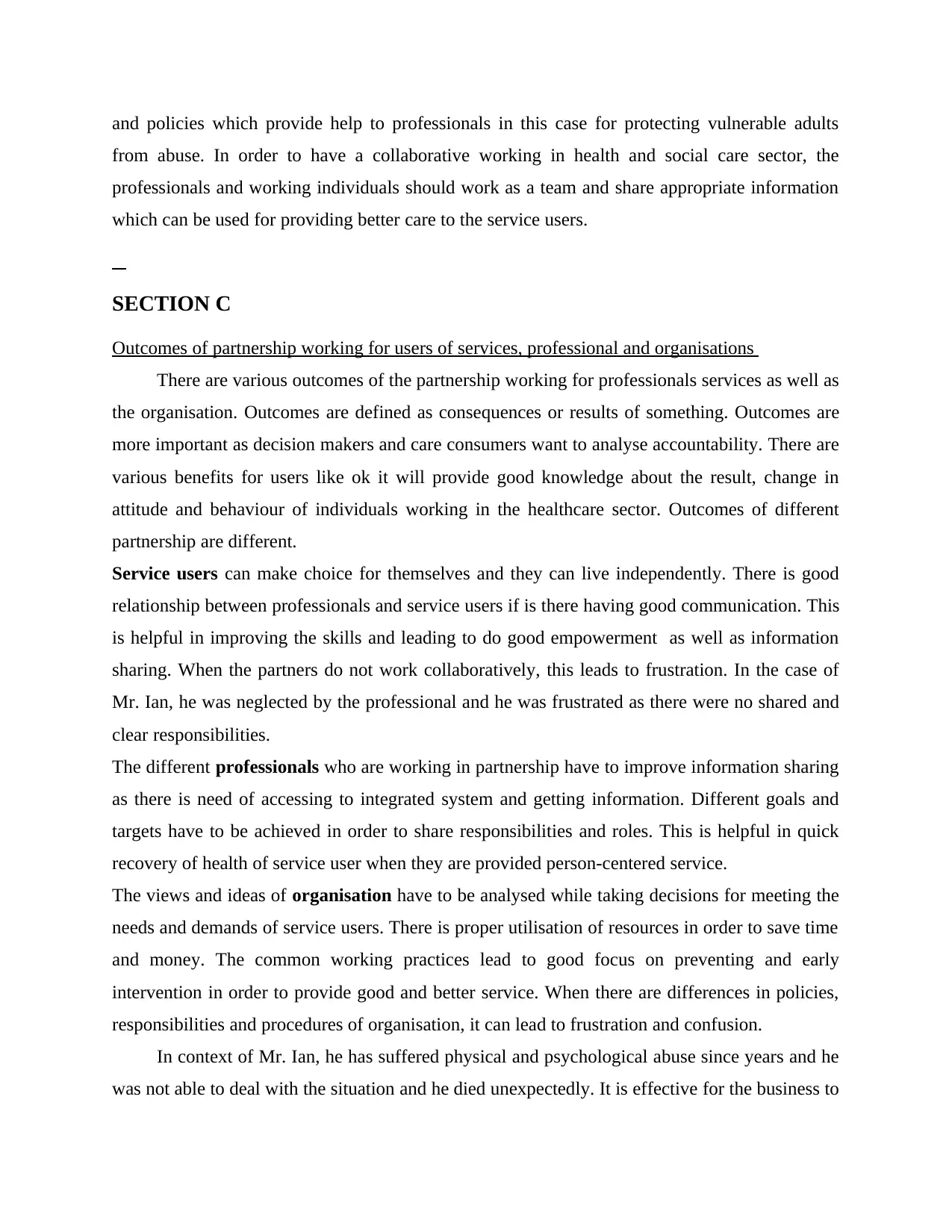
and policies which provide help to professionals in this case for protecting vulnerable adults
from abuse. In order to have a collaborative working in health and social care sector, the
professionals and working individuals should work as a team and share appropriate information
which can be used for providing better care to the service users.
SECTION C
Outcomes of partnership working for users of services, professional and organisations
There are various outcomes of the partnership working for professionals services as well as
the organisation. Outcomes are defined as consequences or results of something. Outcomes are
more important as decision makers and care consumers want to analyse accountability. There are
various benefits for users like ok it will provide good knowledge about the result, change in
attitude and behaviour of individuals working in the healthcare sector. Outcomes of different
partnership are different.
Service users can make choice for themselves and they can live independently. There is good
relationship between professionals and service users if is there having good communication. This
is helpful in improving the skills and leading to do good empowerment as well as information
sharing. When the partners do not work collaboratively, this leads to frustration. In the case of
Mr. Ian, he was neglected by the professional and he was frustrated as there were no shared and
clear responsibilities.
The different professionals who are working in partnership have to improve information sharing
as there is need of accessing to integrated system and getting information. Different goals and
targets have to be achieved in order to share responsibilities and roles. This is helpful in quick
recovery of health of service user when they are provided person-centered service.
The views and ideas of organisation have to be analysed while taking decisions for meeting the
needs and demands of service users. There is proper utilisation of resources in order to save time
and money. The common working practices lead to good focus on preventing and early
intervention in order to provide good and better service. When there are differences in policies,
responsibilities and procedures of organisation, it can lead to frustration and confusion.
In context of Mr. Ian, he has suffered physical and psychological abuse since years and he
was not able to deal with the situation and he died unexpectedly. It is effective for the business to
from abuse. In order to have a collaborative working in health and social care sector, the
professionals and working individuals should work as a team and share appropriate information
which can be used for providing better care to the service users.
SECTION C
Outcomes of partnership working for users of services, professional and organisations
There are various outcomes of the partnership working for professionals services as well as
the organisation. Outcomes are defined as consequences or results of something. Outcomes are
more important as decision makers and care consumers want to analyse accountability. There are
various benefits for users like ok it will provide good knowledge about the result, change in
attitude and behaviour of individuals working in the healthcare sector. Outcomes of different
partnership are different.
Service users can make choice for themselves and they can live independently. There is good
relationship between professionals and service users if is there having good communication. This
is helpful in improving the skills and leading to do good empowerment as well as information
sharing. When the partners do not work collaboratively, this leads to frustration. In the case of
Mr. Ian, he was neglected by the professional and he was frustrated as there were no shared and
clear responsibilities.
The different professionals who are working in partnership have to improve information sharing
as there is need of accessing to integrated system and getting information. Different goals and
targets have to be achieved in order to share responsibilities and roles. This is helpful in quick
recovery of health of service user when they are provided person-centered service.
The views and ideas of organisation have to be analysed while taking decisions for meeting the
needs and demands of service users. There is proper utilisation of resources in order to save time
and money. The common working practices lead to good focus on preventing and early
intervention in order to provide good and better service. When there are differences in policies,
responsibilities and procedures of organisation, it can lead to frustration and confusion.
In context of Mr. Ian, he has suffered physical and psychological abuse since years and he
was not able to deal with the situation and he died unexpectedly. It is effective for the business to
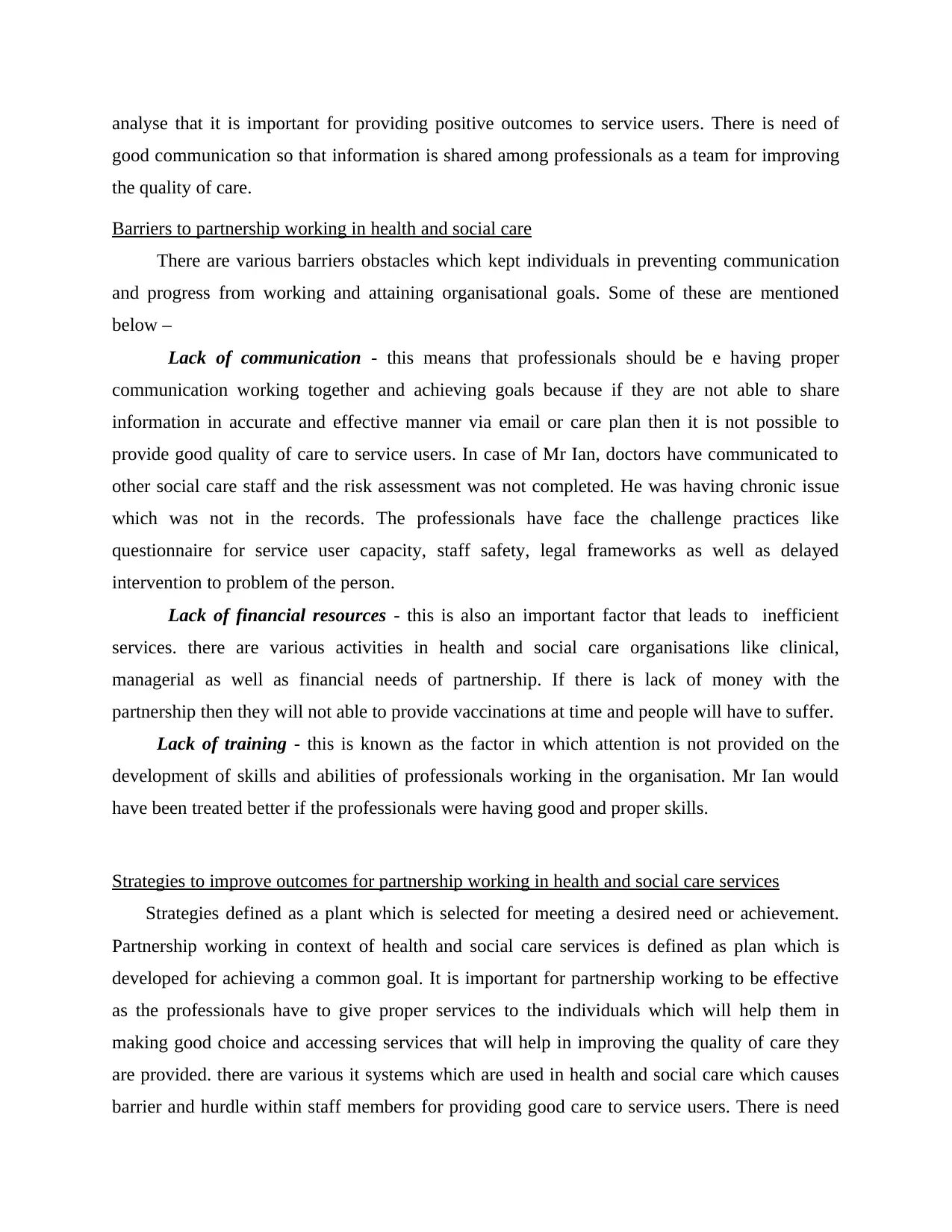
analyse that it is important for providing positive outcomes to service users. There is need of
good communication so that information is shared among professionals as a team for improving
the quality of care.
Barriers to partnership working in health and social care
There are various barriers obstacles which kept individuals in preventing communication
and progress from working and attaining organisational goals. Some of these are mentioned
below –
Lack of communication - this means that professionals should be e having proper
communication working together and achieving goals because if they are not able to share
information in accurate and effective manner via email or care plan then it is not possible to
provide good quality of care to service users. In case of Mr Ian, doctors have communicated to
other social care staff and the risk assessment was not completed. He was having chronic issue
which was not in the records. The professionals have face the challenge practices like
questionnaire for service user capacity, staff safety, legal frameworks as well as delayed
intervention to problem of the person.
Lack of financial resources - this is also an important factor that leads to inefficient
services. there are various activities in health and social care organisations like clinical,
managerial as well as financial needs of partnership. If there is lack of money with the
partnership then they will not able to provide vaccinations at time and people will have to suffer.
Lack of training - this is known as the factor in which attention is not provided on the
development of skills and abilities of professionals working in the organisation. Mr Ian would
have been treated better if the professionals were having good and proper skills.
Strategies to improve outcomes for partnership working in health and social care services
Strategies defined as a plant which is selected for meeting a desired need or achievement.
Partnership working in context of health and social care services is defined as plan which is
developed for achieving a common goal. It is important for partnership working to be effective
as the professionals have to give proper services to the individuals which will help them in
making good choice and accessing services that will help in improving the quality of care they
are provided. there are various it systems which are used in health and social care which causes
barrier and hurdle within staff members for providing good care to service users. There is need
good communication so that information is shared among professionals as a team for improving
the quality of care.
Barriers to partnership working in health and social care
There are various barriers obstacles which kept individuals in preventing communication
and progress from working and attaining organisational goals. Some of these are mentioned
below –
Lack of communication - this means that professionals should be e having proper
communication working together and achieving goals because if they are not able to share
information in accurate and effective manner via email or care plan then it is not possible to
provide good quality of care to service users. In case of Mr Ian, doctors have communicated to
other social care staff and the risk assessment was not completed. He was having chronic issue
which was not in the records. The professionals have face the challenge practices like
questionnaire for service user capacity, staff safety, legal frameworks as well as delayed
intervention to problem of the person.
Lack of financial resources - this is also an important factor that leads to inefficient
services. there are various activities in health and social care organisations like clinical,
managerial as well as financial needs of partnership. If there is lack of money with the
partnership then they will not able to provide vaccinations at time and people will have to suffer.
Lack of training - this is known as the factor in which attention is not provided on the
development of skills and abilities of professionals working in the organisation. Mr Ian would
have been treated better if the professionals were having good and proper skills.
Strategies to improve outcomes for partnership working in health and social care services
Strategies defined as a plant which is selected for meeting a desired need or achievement.
Partnership working in context of health and social care services is defined as plan which is
developed for achieving a common goal. It is important for partnership working to be effective
as the professionals have to give proper services to the individuals which will help them in
making good choice and accessing services that will help in improving the quality of care they
are provided. there are various it systems which are used in health and social care which causes
barrier and hurdle within staff members for providing good care to service users. There is need
⊘ This is a preview!⊘
Do you want full access?
Subscribe today to unlock all pages.

Trusted by 1+ million students worldwide
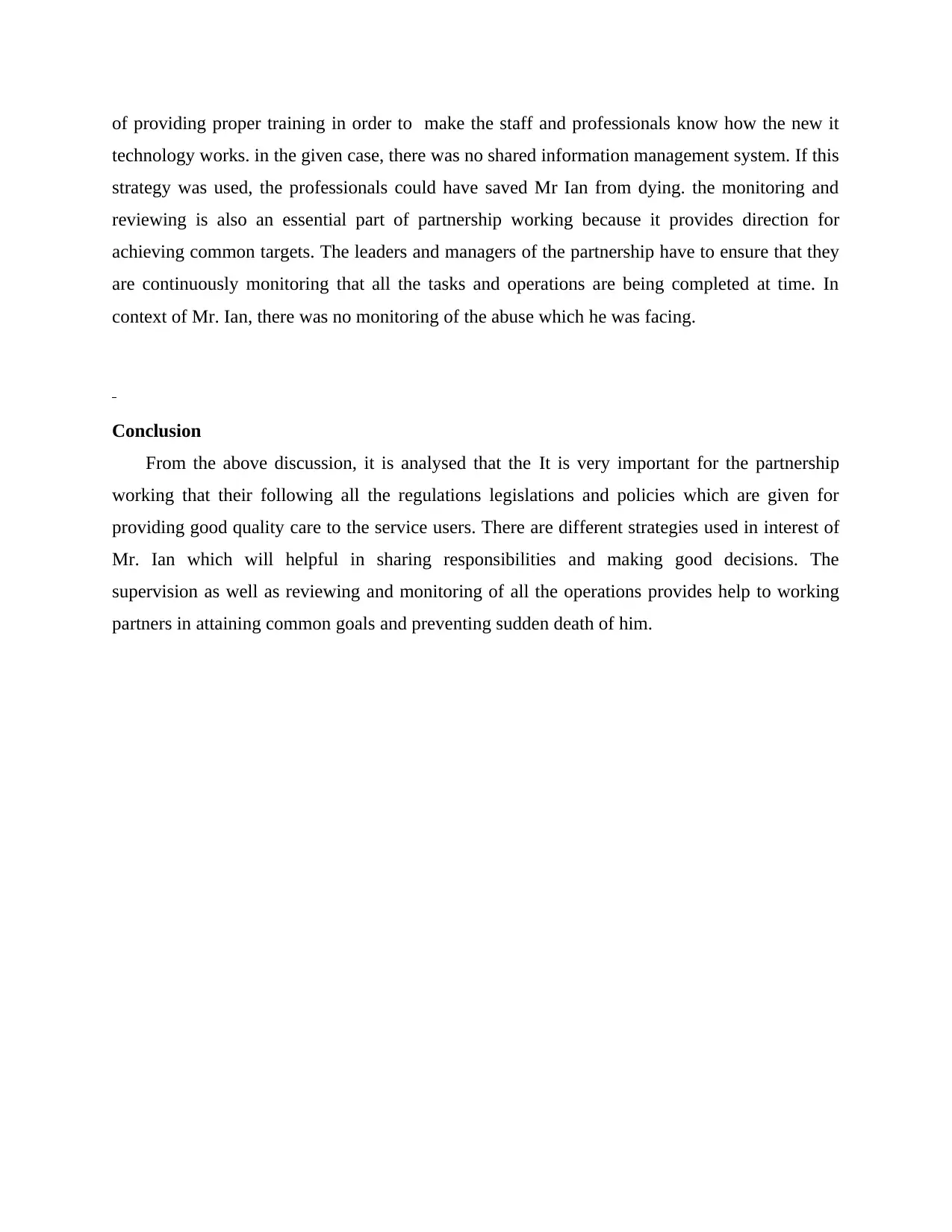
of providing proper training in order to make the staff and professionals know how the new it
technology works. in the given case, there was no shared information management system. If this
strategy was used, the professionals could have saved Mr Ian from dying. the monitoring and
reviewing is also an essential part of partnership working because it provides direction for
achieving common targets. The leaders and managers of the partnership have to ensure that they
are continuously monitoring that all the tasks and operations are being completed at time. In
context of Mr. Ian, there was no monitoring of the abuse which he was facing.
Conclusion
From the above discussion, it is analysed that the It is very important for the partnership
working that their following all the regulations legislations and policies which are given for
providing good quality care to the service users. There are different strategies used in interest of
Mr. Ian which will helpful in sharing responsibilities and making good decisions. The
supervision as well as reviewing and monitoring of all the operations provides help to working
partners in attaining common goals and preventing sudden death of him.
technology works. in the given case, there was no shared information management system. If this
strategy was used, the professionals could have saved Mr Ian from dying. the monitoring and
reviewing is also an essential part of partnership working because it provides direction for
achieving common targets. The leaders and managers of the partnership have to ensure that they
are continuously monitoring that all the tasks and operations are being completed at time. In
context of Mr. Ian, there was no monitoring of the abuse which he was facing.
Conclusion
From the above discussion, it is analysed that the It is very important for the partnership
working that their following all the regulations legislations and policies which are given for
providing good quality care to the service users. There are different strategies used in interest of
Mr. Ian which will helpful in sharing responsibilities and making good decisions. The
supervision as well as reviewing and monitoring of all the operations provides help to working
partners in attaining common goals and preventing sudden death of him.
Paraphrase This Document
Need a fresh take? Get an instant paraphrase of this document with our AI Paraphraser
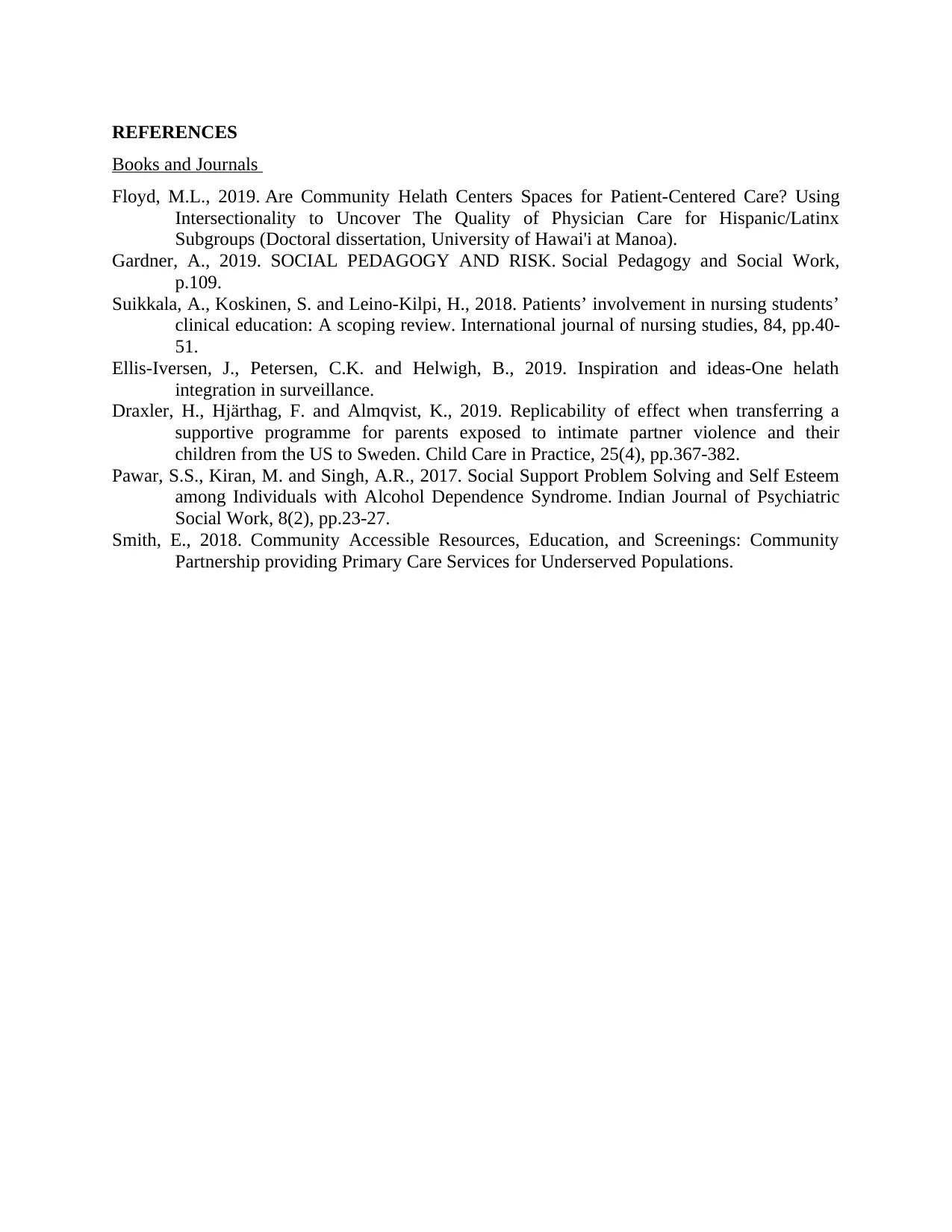
REFERENCES
Books and Journals
Floyd, M.L., 2019. Are Community Helath Centers Spaces for Patient-Centered Care? Using
Intersectionality to Uncover The Quality of Physician Care for Hispanic/Latinx
Subgroups (Doctoral dissertation, University of Hawai'i at Manoa).
Gardner, A., 2019. SOCIAL PEDAGOGY AND RISK. Social Pedagogy and Social Work,
p.109.
Suikkala, A., Koskinen, S. and Leino-Kilpi, H., 2018. Patients’ involvement in nursing students’
clinical education: A scoping review. International journal of nursing studies, 84, pp.40-
51.
Ellis-Iversen, J., Petersen, C.K. and Helwigh, B., 2019. Inspiration and ideas-One helath
integration in surveillance.
Draxler, H., Hjärthag, F. and Almqvist, K., 2019. Replicability of effect when transferring a
supportive programme for parents exposed to intimate partner violence and their
children from the US to Sweden. Child Care in Practice, 25(4), pp.367-382.
Pawar, S.S., Kiran, M. and Singh, A.R., 2017. Social Support Problem Solving and Self Esteem
among Individuals with Alcohol Dependence Syndrome. Indian Journal of Psychiatric
Social Work, 8(2), pp.23-27.
Smith, E., 2018. Community Accessible Resources, Education, and Screenings: Community
Partnership providing Primary Care Services for Underserved Populations.
Books and Journals
Floyd, M.L., 2019. Are Community Helath Centers Spaces for Patient-Centered Care? Using
Intersectionality to Uncover The Quality of Physician Care for Hispanic/Latinx
Subgroups (Doctoral dissertation, University of Hawai'i at Manoa).
Gardner, A., 2019. SOCIAL PEDAGOGY AND RISK. Social Pedagogy and Social Work,
p.109.
Suikkala, A., Koskinen, S. and Leino-Kilpi, H., 2018. Patients’ involvement in nursing students’
clinical education: A scoping review. International journal of nursing studies, 84, pp.40-
51.
Ellis-Iversen, J., Petersen, C.K. and Helwigh, B., 2019. Inspiration and ideas-One helath
integration in surveillance.
Draxler, H., Hjärthag, F. and Almqvist, K., 2019. Replicability of effect when transferring a
supportive programme for parents exposed to intimate partner violence and their
children from the US to Sweden. Child Care in Practice, 25(4), pp.367-382.
Pawar, S.S., Kiran, M. and Singh, A.R., 2017. Social Support Problem Solving and Self Esteem
among Individuals with Alcohol Dependence Syndrome. Indian Journal of Psychiatric
Social Work, 8(2), pp.23-27.
Smith, E., 2018. Community Accessible Resources, Education, and Screenings: Community
Partnership providing Primary Care Services for Underserved Populations.
1 out of 11
Related Documents
Your All-in-One AI-Powered Toolkit for Academic Success.
+13062052269
info@desklib.com
Available 24*7 on WhatsApp / Email
![[object Object]](/_next/static/media/star-bottom.7253800d.svg)
Unlock your academic potential
Copyright © 2020–2025 A2Z Services. All Rights Reserved. Developed and managed by ZUCOL.




